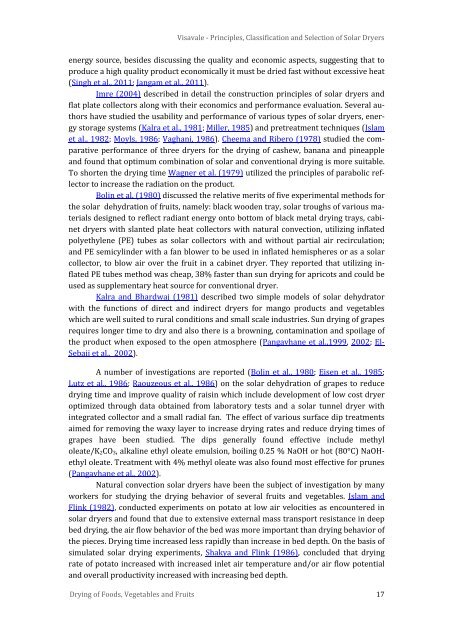Solar Drying: Fundamentals,Applications and Innovations - National ...
Solar Drying: Fundamentals,Applications and Innovations - National ...
Solar Drying: Fundamentals,Applications and Innovations - National ...
Create successful ePaper yourself
Turn your PDF publications into a flip-book with our unique Google optimized e-Paper software.
Visavale - Principles, Classification <strong>and</strong> Selection of <strong>Solar</strong> Dryers<br />
energy source, besides discussing the quality <strong>and</strong> economic aspects, suggesting that to<br />
produce a high quality product economically it must be dried fast without excessive heat<br />
(Singh et al., 2011; Jangam et al., 2011).<br />
Imre (2004) described in detail the construction principles of solar dryers <strong>and</strong><br />
flat plate collectors along with their economics <strong>and</strong> performance evaluation. Several authors<br />
have studied the usability <strong>and</strong> performance of various types of solar dryers, energy<br />
storage systems (Kalra et al., 1981; Miller, 1985) <strong>and</strong> pretreatment techniques (Islam<br />
et al., 1982; Moyls, 1986; Vaghani, 1986). Cheema <strong>and</strong> Ribero (1978) studied the comparative<br />
performance of three dryers for the drying of cashew, banana <strong>and</strong> pineapple<br />
<strong>and</strong> found that optimum combination of solar <strong>and</strong> conventional drying is more suitable.<br />
To shorten the drying time Wagner et al. (1979) utilized the principles of parabolic reflector<br />
to increase the radiation on the product.<br />
Bolin et al. (1980) discussed the relative merits of five experimental methods for<br />
the solar dehydration of fruits, namely: black wooden tray, solar troughs of various materials<br />
designed to reflect radiant energy onto bottom of black metal drying trays, cabinet<br />
dryers with slanted plate heat collectors with natural convection, utilizing inflated<br />
polyethylene (PE) tubes as solar collectors with <strong>and</strong> without partial air recirculation;<br />
<strong>and</strong> PE semicylinder with a fan blower to be used in inflated hemispheres or as a solar<br />
collector, to blow air over the fruit in a cabinet dryer. They reported that utilizing inflated<br />
PE tubes method was cheap, 38% faster than sun drying for apricots <strong>and</strong> could be<br />
used as supplementary heat source for conventional dryer.<br />
Kalra <strong>and</strong> Bhardwaj (1981) described two simple models of solar dehydrator<br />
with the functions of direct <strong>and</strong> indirect dryers for mango products <strong>and</strong> vegetables<br />
which are well suited to rural conditions <strong>and</strong> small scale industries. Sun drying of grapes<br />
requires longer time to dry <strong>and</strong> also there is a browning, contamination <strong>and</strong> spoilage of<br />
the product when exposed to the open atmosphere (Pangavhane et al.,1999, 2002; El-<br />
Sebaii et al., 2002).<br />
A number of investigations are reported (Bolin et al., 1980; Eisen et al., 1985;<br />
Lutz et al., 1986; Raouzeous et al., 1986) on the solar dehydration of grapes to reduce<br />
drying time <strong>and</strong> improve quality of raisin which include development of low cost dryer<br />
optimized through data obtained from laboratory tests <strong>and</strong> a solar tunnel dryer with<br />
integrated collector <strong>and</strong> a small radial fan. The effect of various surface dip treatments<br />
aimed for removing the waxy layer to increase drying rates <strong>and</strong> reduce drying times of<br />
grapes have been studied. The dips generally found effective include methyl<br />
oleate/K 2CO 3, alkaline ethyl oleate emulsion, boiling 0.25 % NaOH or hot (80°C) NaOHethyl<br />
oleate. Treatment with 4% methyl oleate was also found most effective for prunes<br />
(Pangavhane et al., 2002).<br />
Natural convection solar dryers have been the subject of investigation by many<br />
workers for studying the drying behavior of several fruits <strong>and</strong> vegetables. Islam <strong>and</strong><br />
Flink (1982), conducted experiments on potato at low air velocities as encountered in<br />
solar dryers <strong>and</strong> found that due to extensive external mass transport resistance in deep<br />
bed drying, the air flow behavior of the bed was more important than drying behavior of<br />
the pieces. <strong>Drying</strong> time increased less rapidly than increase in bed depth. On the basis of<br />
simulated solar drying experiments, Shakya <strong>and</strong> Flink (1986), concluded that drying<br />
rate of potato increased with increased inlet air temperature <strong>and</strong>/or air flow potential<br />
<strong>and</strong> overall productivity increased with increasing bed depth.<br />
<strong>Drying</strong> of Foods, Vegetables <strong>and</strong> Fruits 17

















